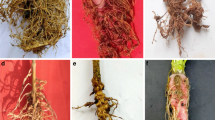Abstract
A study was conducted to determine the role of the earhead bug (Leptocorisa acuta Thumb. [Heteroptera: Alydidae]) in the manifestation of sheath rot disease caused bySarocladium oryzae (Sawada) W. Gams & D. Hawksw. [syn.Acrocylindrium oryzae (Sawada)], with the aim of formulating effective control measures against the disease. In greenhouse studies, rice plants (Oryza sativa, cv. IR 20) exhibited typical sheath rot within 12 days whenS. oryzae spore suspensions (5 x 107 conidia/ml) were sprayed on earhead bug-infested plants (5 bugs/tiller). In a comparison of various inoculation methods, swabbing a spore suspension (using a camelľs hair brash) on the sheath surface of earhead bug-infested plants, and inserting a single-grain culture inside the sheath of infested plants, produced the greatest disease severity within 18 days of inoculation. The results demonstrated (a) the role of the earhead bug in sheath rot disease manifestation and (b) that rice genotypes can be screened effectively and rapidly in the greenhouse for resistance to the disease, using the described inoculation techniques.
Similar content being viewed by others
References
Amin, K.S., Sharma, B.D. and Das, C.R. (1974) Occurrence in India of sheath-rot of rice caused byAcrocylindrium.Plant Dis. Rep. 58:358–360.
Chen, M.J. (1957) Studies on sheath rot of rice plants.J. Agric. For. Taiwan 6:358–360.
Estrada, B.S., Sanchez, CM. and Crill, P. (1979) Evaluation of screening methods for sheath rot resistance of rice.Plant Dis. Rep. 63:908–911.
Hsieh, S.P.Y., Liang, W.J. and Chan, S.Y. (1977) Etiological studies on the sterility of rice plant. 1. Association of sheath rot fungus,Acrocylindrium oryzae Sawada with sterile rice plant.Plant Prot. Bull. 19:30–36.
Kawamura, E. (1940) A note on sheath rot of rice plant with special reference to its causal organism,Acrocylindrium oryzae Saw.Ann. Phytopathol. Soc. Jpn. 10:55–59.
Lakshmanan, P. (1984) Effective control of sheath rot (ShR) disease.Int. Rice Res. Newsl. 9(5): 14.
Lakshmanan, P., Manoharan, T. and Mohan, S. (1988) Role of mealy bug on sheath rot disease manifestation in rice plants.Trop. Pest Manage. 34 (3):356–357.
Sutton, W.J. and Shane, W.W. (1983) Epidemiology of the perfect stage ofGlomerella cingulata on apples.Phytopathology 73:1179–1183.
Tasugi, H. and Ikeda, Y. (1956) Studies on the sheath rot of rice plant caused byAcrocylindrium oryzae Sawada.Bull. Natl. Inst. Agric. Sci. Ser. C 6:151–166.
Author information
Authors and Affiliations
Rights and permissions
About this article
Cite this article
Lakshmanan, P., Kumar, S.M. & Velusamy, R. Role of earhead bug (leptocorisa acuta) feeding on sheath rot disease caused bysarocladium oryzae inoryza sativa in India. Phytoparasitica 20, 107–112 (1992). https://doi.org/10.1007/BF02981276
Received:
Issue Date:
DOI: https://doi.org/10.1007/BF02981276




